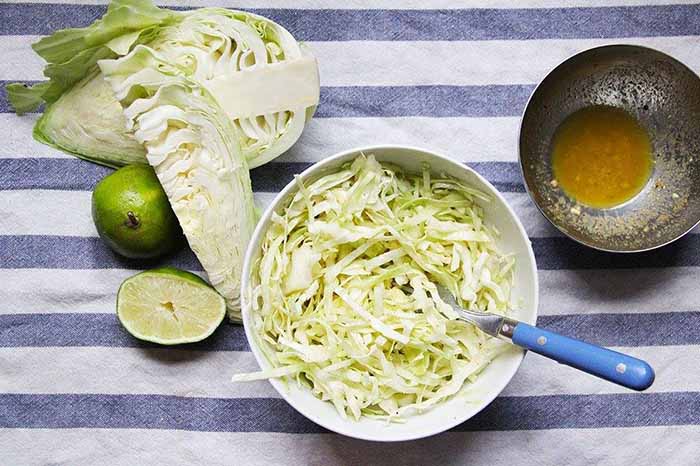|
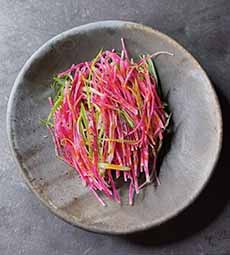
[1] Shredded vegetable salad as a pretty first course (photo © Contra Restaurant | NYC).

[2] A shredded salad of red cabbage, carrot, and mint. Here’s the recipe (photo © Recipe Tin Eats).
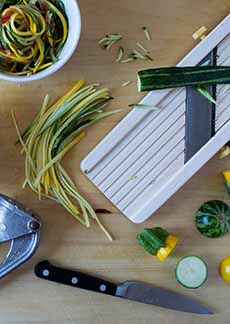
[3] Shredding vegetables on a mandoline (photo © Quinciple | Facebook).
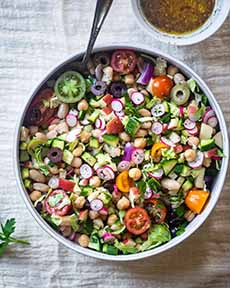
[4] Chopped salad (photo © California Olive Ranch | Facebook).

[5] Use a vegetable peeler to cut wide slices for a shaved salad (photo © Gardenia Restaurant | NYC).
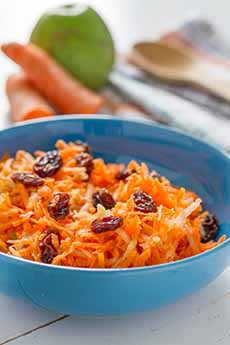
[6] Carrot-raisin salad, an American favorite. Here’s the recipe (photo © Anaumenko | Panther Media).
|
|
Fans of carrot salad (photo #6) and coleslaw (photo #7) are familiar with grating or shredding the carrots and cabbages. But how about other types of shredded salad?
As you can see from photo #1, a shredded salad with different colored vegetables can be stacked to create an elegant first course.
Or, in photo #2, the shredded vegetables can be blended together for a more casual méange.
This article focuses on shredded salads that you can make year-round from your favorite raw vegetables.
But we’d first like to explain our point of view that there’s a difference between a shredded salad and a chopped salad (photo #4), although these terms seem to be used interchangeably online. There’s also a related option, the shaved salad (photo #5).
Most of the recipes online are for chopped salad.
A chopped salad cuts the ingredients into small dice or another small shape. Some add colored ingredients, while others are largely “beige.”
A shredded salad cuts the ingredients into slender slices—such as a long julienne, allumette (matchstick), or jardiniere (see them here). They can be shorter or longer. With a shredded salad, the visual appeal comes from using different-colored vegetables (that’s why shreds of carrot are added to the whiteish coleslaw). See the list of colored vegetable options below.
A shaved salad is one where root vegetables are shaved into wide ribbons with a vegetable peeler (photo #5).
All three can be garnished—with cheese, herbs, nuts, raisins, seeds, strips of meat, etc.
DIFFERENT WAYS TO SHRED VEGETABLES & FRUITS
To shred, or thinly slice, requires a firm-flesh vegetable or fruit (options below).
Knife: A sharp knife is the original shredder, used to make julienne strips and other cuts. Unless you have the speed of a professional chef, a knife requires more patience than the other options.
Box grater: The box grater was invented in the 1540s to grate cheese. Both François Boullier of France and Isaac Hunt of England are given credit for the invention. It is very good for grating hard cheeses and vegetables (watch your knuckles!). But even the larger holes create relatively short shreds that are fine for carrot salad, but not elegant enough for the shredded salad in photo #1. You could shred a selection of different colored vegetables—beets, broccoli stalks, carrots, cucumbers, purple/red cabbage, zucchini, for example—and plate small mounds of each color, with a dressing to drizzle.
Mandoline: This board-based slicer (photo #3) was first documented by Bartolomeo Scappi, a famous Italian Renaissance chef for cardinals and popes in the 16th century. It was used to slice thin, uniform slices of vegetables and fruits, and remains popular today among chefs and home cooks alike. The smaller, flat version known as a Benriner slicer was created in 1940 in Japan by Uyuki Yamamoto, who first used it to slice radishes.
Vegetable peeler. Numerous styles of vegetable peelers have been invented over the centuries. In the 1800s alone, 500 peeler inventions were patented [source]. An alternative to using a knife, in addition to peeling vegetables it enables a wide swath of peeled vegetables to be stacked and cut into julienne and other slices.
Microplane: Fast-forward to the mid-1990s: the Microplane was invented by Richard Grace after his wife continued to borrow the rasp from his toolkit for grating and zesting. Its handle makes it a vast improvement over the box grater, protecting one’s knuckles from scrapes. However, like the box grater, even the widest version (the ribbon Microplane) produces relatively short shreds.
Food processor: Invented in France by Pierre Verdon, the Robot-Coupe was first exhibited in Paris in 1971. The Cuisinart followed, introduced to the U.S. in 1973. KitchenAid’s version was introduced in 1993. All of these have shredding discs, but most discs make shreds similar to the box grater.
Spiralizer: Also known as a spiral vegetable slicer, the spiralizer cuts firm fruits and vegetables into long, linguine-like strands. But amazingly, we can’t find out who invented the vegetable spiralizer*. According to Dictionary.com, the word first appeared in the 2000-2005 timeframe. However “zoodle,” the zucchini noodle made with a spiralizer, first appears in 1991. Zoodles could be made with a paring knife or a mechanical paring device used for apples and potatoes.
Check out this video for three ways to cut vegetables for a shredded salad.
Are you ready to shred?
VEGETABLES TO SHRED
Note that these are the same vegetables that can be sliced for crudités.
Green: asparagus stalks, Bartlett and green d’Anjou pears, broccoli stems, bell peppers, cabbages, celery, cucumbers, green-skinned apples, kohlrabi, pears, scallions, zucchini
Orange: carrots, orange beets, orange bell peppers, sweet potatoes (not yams†)
Red/purple: beets, Okinawa sweet potatoes, purple sweet potatoes, red Bartlett and red d’Anjou pears, red bell peppers, red onions, red/purple cabbages, red-skinned apples
White: Asian pears, celeriac (celery root), daikon radishes, fennel, jicama, sweet onions, turnips
Yellow: pineapples, summer squash, yellow beets, yellow bell peppers
For more colored vegetables: http://blog.thenibble.com/2012/03/09/tip-of-the-day-eat-the-rainbow-for-national-nutrition-month/
________________
*According to Merriam-Webster, the word “zoodle,” for zucchini noodle (a gluten-alternative to pasta), first appears in 1991. However, the zoodle craze in the U.S. began about 2014, when the media began to extensively feature content and recipes for spiralized vegetables. The term “spiralizer” first appears in the 2000-2005 timeframe, according to Dictionary.com.
†The terms “sweet potato” and “yam” are used interchangeably in the U.S., but there is a difference. Yams, which have white flesh, must be cooked thoroughly to remove naturally occurring toxic substances.
‡Non-shaveable vegetables like cherry tomatoes, broccoli and cauliflower florets, endive, green beans, pea pods, radishes, and others are also popular crudités.
|
